Mary Anne Yarde's Blog: The Coffee Pot Book Club , page 212
January 5, 2017
Book Spotlight ~ Secrets Of The Home Wood #YA #fantasy @AuthorJWhitley
SECRETS OF THE HOME WOOD: THE SACRIFICEByJulie Whitley
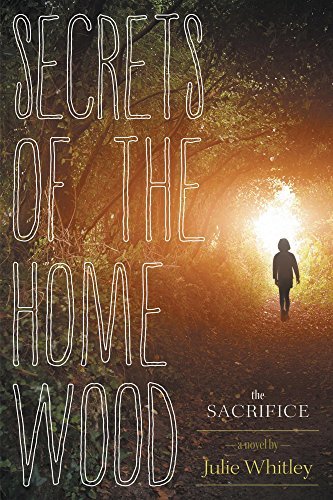
For Jonathon, the Home Wood that borders his grandfather’s farm has always been a source of mystery and dread. Strange half-heard rumours passed among aunts, uncles and cousins never quite add up.
More than twenty years ago, his father—when he was Jonathon’s age—was swallowed up by the Home Wood for more than a day and came back badly injured. That was when his grandfather forbade any family member from venturing back there.
And so when from his bedroom window, three days after his mother left without a word, Jonathon sees his father cross into the Home Wood, his gut tells him something is very wrong. Deceiving his grandfather, Jonathon sets out after his father and makes his way, for the first time in his life, into the heart of the woods.
What he finds there is beyond even his wildest imagination.
Purchase links FriesenPress Amazon
About the Author

Reading and writing has been a life long passion. Writing, however took a back-seat to a career in health care and a ten year sojourn through two degrees. On retirement, she was excited to have the opportunity to return to creative writing. Secrets of the Home Wood: the Sacrifice, grew out of an in-class writing exercise nearly thirty years ago. More courses post-retirement and a writing group provided the motivation to finish her debut novel.
The structure of the story was a journey in itself. As the new mother of an adopted teenage daughter, Julie was introduced to a new genre, YA. She discovered that other mothers of teenagers were also reading their daughters’ books. Her favourite book had a role for the father and grandfather of the young protagonist — and the style for Secrets of the Home Wood was inspired. From there, the story took on a life of its own, the struggle was over. Julie wanted her story to appeal not only to the young but to the older readers as well. Her choice was rewarded in November when Secrets of the Home Wood: the Sacrifice was selected as the 2016 Book Excellence Award winner for fantasy. A gratifying motivation to continue to write. The sequel, The Stalker is on track to be completed in summer, 2017.
Useful linkshttp://www.juliewhitley.com/bloghttp://facebook.com/juliewhitleyauthorhttp://twitter.com/AuthorJWhitley
Published on January 05, 2017 00:00
January 4, 2017
Author's Inspiration ~ Jana Petkin #Histfic @AuthoJana
I am so excited to start off this years 'Author's Inspiration' with one of my favourite historical fiction authors. So please give a warm Coffee Pot welcome to Jana Petkin.
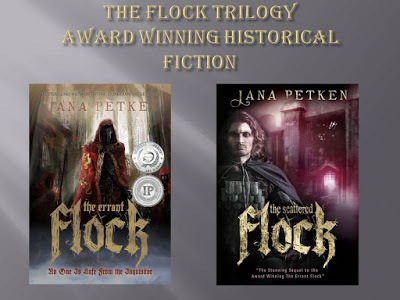
Valencia, Spain, 1491
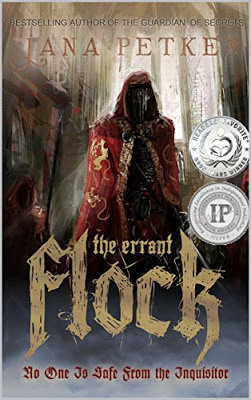
The ambitions of four men merge and collide in a deadly game of intrigue.
David Sanz, a young militiaman, is forced to carry out a heinous crime, and he becomes an unwitting pawn in a tense battle for power.
Luis Peráto, the duke of Sagrat, sacrifices his own people to cover up dark secrets that could see him burnt at the stake for treason.
Sergio Garcia, Sagrat’s lord treasurer, is a cruel and unscrupulous man, willing to eliminate anyone who opposes his rise to power.
The inquisitor, Gaspar de Amo, zealously punishes heretics for their sins against Rome and her Holy Office. But bringing the Inquisition to the town of Sagrat proves more challenging than he or the church could ever have envisaged.
In the midst of chaos, the people of Sagrat, terrorized by a series of murders, face an even greater danger with the arrival of the Inquisition and the unimaginable horrors it brings.
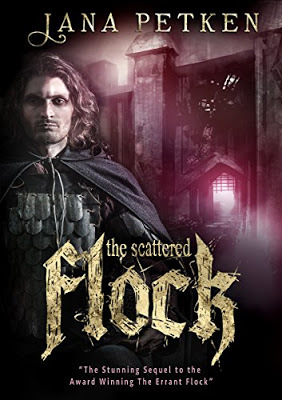 Jana Petken presents The Scattered Flock, a suspenseful, compelling sequel to the multi award winning, The
Jana Petken presents The Scattered Flock, a suspenseful, compelling sequel to the multi award winning, The Jana Petken presents The Scattered Flock, a suspenseful, compelling sequel to the multi award winning, The Errant Flock
David Sanz’s journey south is halted abruptly after a devastating turn of events. In a tense battle for survival against thieves and the militia he has been fleeing from, he finds himself shackled and incarcerated in the prison he once guarded.
The Duke of Sagrat’s brother, Rafael Perato, has survived the war, and the royal court’s treacherous intrigues, but when news of his brother’s death reaches their Most Catholic Majesties his life is thrown into turmoil. Banished by the king, and tasked with carrying out insurmountable missions, he becomes entangled in a web of deadly plots and subterfuge, which threaten not only Sagrat but his very life.
In this fast paced epic, David Sanz and Rafael Perato face adversaries more devious and powerful than themselves, and it is only faith, courage, and unlikely alliances, that may save them both from the Inquisitor and the deadly marauder, Alejandro.
Author’s Inspiration
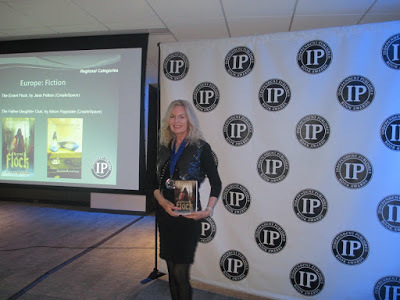
How could I not want to write this series, I asked myself? I live on the East coast of Spain, surrounded by medieval and Roman castles, walled towns, Jewish quarters that pre-date the Expulsion of the Jews in 1492, and most importantly, magnificent churches and cathedrals built during the 15thand 16th century.
The Spanish Inquisition was not a fleeting fad that passed into oblivion after a few years; it was a law and a way of life that endured for more than four centuries, leaving its mark on the Spanish people right up until the 1930’s and Spain’s Civil War.I found writing the two books difficult at times, as the subject matter and research was disturbing and even distasteful to me, but I knew that there was no way to tell the story unless I plunged head first into the truth and emotions brimming over during the Inquisition period.The characters in the story are completely fictional, as are some of the events they live through, however I did try to stick faithfully to the backdrop and people of the time to make the book as authentic and as true to life as possible.Spain in the 15th century was run by a feudal hierarchy, with noblemen exempt from paying taxes, being given huge power over their lands and peoples, yet still being beholden to their monarchs’ whims.The powerful Catholic Church and Inquisition Council that operated in conjunction with the civil courts also had their own laws, judges and jewry who zealously hunted, found and punished heretics. I was, in part, also drawn to write this story because of the inquisitors’ utter carelessness when it came to castigating a population who were in many cases innocent of crimes – indeed, most people were found guilty, simply because they dared to think differently from the norm, were enlightened, or worshipped something other than Rome’s and the Inquisition’s view of God and his laws.I was also inspired because I see history repeating itself, to a certain extent, in many parts of the world with the terror groups who are infinitely more evil than the Inquisition, but whose mantra is similar: Worship God our way, believe and act the way we do without question and within our manmade doctrine, or die or rot in prison.The Flock Trilogy books one and two challenges the subject of heresy, loyalty, faith, and evil. It is a thriller, a dilemma, a look into the minds of the most powerful and the downtrodden, fighting to keep their dignity, faith and their heads on their bodies. It is also a story of love of family and the lengths men will go to keep their nearest and dearest safe.
Links for PurchaseErrantFlock ~ Amazon USScatteredFlock ~ Amazon US
About the author
 Jana Petken served in the (British) Royal Navy as a leading Wren Regulator, equivalent to a sergeant in the military police.
Jana Petken served in the (British) Royal Navy as a leading Wren Regulator, equivalent to a sergeant in the military police. After the Navy she worked for a travel company as an overseas representative.
She was a security guard at the BBC World Service radio station. Afterwards she spent twelve years as a bodyguard for a Saudi Arabian Princess.
Her final career was as a cabin-crew member for British Airways. Unfortunately, she suffered serious injuries on board a flight. The aircraft, a Boeing 747, was flying at 39,000 feet above Africa when it was caught in clear-air turbulence. As a result of that accident, she endured three major operations on her spinal cord, and was forced into retirement.
Jana Petken is a multi award winning and best selling historical fiction author. Her books include: The Guardian of Secrets. (2013)
The Mercy Carver Series: Dark Shadows, book 1, and Blood Moon, book 2. (2014)
The Errant Flock: The Flock Trilogy Book 1. (2015)
Swearing Allegiance. (2016)
The Scattered Flock (The Flock Trilogy book 2)
Useful Links
www.janapetkenauthor.com
Published on January 04, 2017 00:00
January 3, 2017
#bookreview ~ The Beauty Shop #HistFic @Suzy_Henderson
The Beauty Shop by Suzy Henderson
 England,1942. After three years of WWII, Britain is showing the scars. But in this darkest of days, three lives intertwine, changing their destinies and those of many more.
England,1942. After three years of WWII, Britain is showing the scars. But in this darkest of days, three lives intertwine, changing their destinies and those of many more.
Dr Archibald McIndoe, a New Zealand plastic surgeon with unorthodox methods, is on a mission to treat and rehabilitate badly burned airmen – their bodies and souls. With the camaraderie and support of the Guinea Pig Club, his boys battle to overcome disfigurement, pain, and prejudice to learn to live again.
John ‘Mac’ Mackenzie of the US Air Force is aware of the odds. He has one chance in five of surviving the war. Flying bombing missions through hell and back, he’s fighting more than the Luftwaffe. Fear and doubt stalk him on the ground and in the air, and he’s torn between his duty and his conscience.
Shy, decent and sensible Stella Charlton’s future seems certain until war breaks out. As a new recruit to the WAAF, she meets an American pilot on New Year’s Eve. After just one dance, she falls head over heels for the handsome airman. But when he survives a crash, she realises her own battle has only just begun.
Based on a true story, "The Beauty Shop" is a moving tale of love, compassion, and determination against a backdrop of wartime tragedy. *** What did I make of the book?
Sometimes ordinary people do the most extraordinary things. Based on a true story, The Beauty Shop is an evocative tale full of bravery, suffering and hope.
"Over sexed, over paid, and over here." John ‘Mac’ Mackenzie of the US Air Force is here to do a job. A pilot of the formidable B-17, it is his responsibility to bring his crew safely home. Mac was very real in the telling. He understands the important role he has to play, but he struggles with the reality of what each mission means — not only for himself and his crew, but for those poor innocent civilians that just so happen to be in the wrong place at the wrong time when his Flying Fortress drops those bombs. Ms Henderson creates a vivid account of what life must have been like for those brave men who were willing to make the ultimate sacrifice to bring about an end to the war.
Stella didn't ask for this war, but she is determined to help in any way she can. She joins the WAAF, determined to do her bit. Her mother wants to see her settled down and Alex seems to tick all the right boxes. But then at a dance, her eyes meet those of a young American pilot and life as she knows it will never be the same again.
Dr Archibald McIndoe, a New Zealand plastic surgeon, has dedicated his life to helping those who have been horrifically injured while fighting for freedom. He is determined to make a difference. Archie isn't just a Dr he becomes a friend to his patients — he is a beacon of hope when it seems all light has been distinguished. He is the unsung hero of a tragedy.
The Beauty Shop really got under my skin. The realism was so vivid it felt like I was sat next to Mac while he flew into Hell. I felt every jerk, every shudder that the B-17 made. I could feel the fear in the hearts of the men and the desperate relief they felt when they crossed back over the Channel and made a safe touch-down on the runway.
I adored the characterisation of Mac. He is full of integrity and decency. He is the kind of man you would want your daughter to bring home!! Through him, Ms Henderson shows the horror of war and the comradeship that such a thing brings.
Stella has the most beautiful soul. She wants to do what is right by everyone, and is desperate to make her mother happy, but when she meets Mac everything changes. She doesn't want to fall in love with him, but some things cannot be denied. She is steadfast in her loyalty to him, and when things take a turn for the worse and Mac finds himself in the hospital, Stella is determined to be there for him, despite what he might have to say on the subject! Love, it seems, really does conquer all.
I was truly humbled when I read about Archibald McIndoe, who is based on a real person. Mclndoe did so much for those brave young servicemen who had walked through Hell and had the scars to prove it. If only there were more men like him then maybe the world would be in a different place than it is today. A sobering thought.
The Beauty Shop is one of the most emotionally captivating stories I have read in a long while and one that will stay with me for a long time. I adored the characters, the setting, and the story. This one is a keeper. If I could give it more stars, then I would! I Highly Recommend.
Links for Purchase Amazon
About the author Suzy Henderson was born in the North of England, but a career in healthcare would eventually take her to rural Somerset. Years later, she decided to embark upon a degree in English Literature with The Open University.
Suzy Henderson was born in the North of England, but a career in healthcare would eventually take her to rural Somerset. Years later, she decided to embark upon a degree in English Literature with The Open University.
That was the beginning of a new life journey, rekindling her love of writing and passion for history. With an obsession for military and aviation history, she began to write. It was an old black and white photograph of her grandmother that caught Suzy’s imagination many years ago. Her grandmother died in 1980 as did her tales of war as she never spoke of those times. When she decided to research her grandmother’s war service in the WAAF, things spiralled from there. Stories came to light, little-known stories and tragedies and it is such discoveries that inform her writing.Having relocated to the wilds of North Cumbria, she has the Pennines in sight and finally feels at home. Suzy is a member of the Historical Novel Society and the Romantic Novelists Association. "The Beauty Shop" is her debut novel and will be released 28th November 2016.Useful Linkshttp://www.suzyhendersonauthor.com/suzyhenderson.wordpress.comhttp://lowfellwritersplace.blogspot.co.uk/https://www.goodreads.com/author/show/15954239.Suzy_Hendersonhttps://www.facebook.com/SuzyHendersonAuthor/https://twitter.com/Suzy_Hendersonhttps://plus.google.com/u/0/109057622139171622985https://uk.linkedin.com/in/suzy-henderson-714a4353
 England,1942. After three years of WWII, Britain is showing the scars. But in this darkest of days, three lives intertwine, changing their destinies and those of many more.
England,1942. After three years of WWII, Britain is showing the scars. But in this darkest of days, three lives intertwine, changing their destinies and those of many more.Dr Archibald McIndoe, a New Zealand plastic surgeon with unorthodox methods, is on a mission to treat and rehabilitate badly burned airmen – their bodies and souls. With the camaraderie and support of the Guinea Pig Club, his boys battle to overcome disfigurement, pain, and prejudice to learn to live again.
John ‘Mac’ Mackenzie of the US Air Force is aware of the odds. He has one chance in five of surviving the war. Flying bombing missions through hell and back, he’s fighting more than the Luftwaffe. Fear and doubt stalk him on the ground and in the air, and he’s torn between his duty and his conscience.
Shy, decent and sensible Stella Charlton’s future seems certain until war breaks out. As a new recruit to the WAAF, she meets an American pilot on New Year’s Eve. After just one dance, she falls head over heels for the handsome airman. But when he survives a crash, she realises her own battle has only just begun.
Based on a true story, "The Beauty Shop" is a moving tale of love, compassion, and determination against a backdrop of wartime tragedy. *** What did I make of the book?
Sometimes ordinary people do the most extraordinary things. Based on a true story, The Beauty Shop is an evocative tale full of bravery, suffering and hope.
"Over sexed, over paid, and over here." John ‘Mac’ Mackenzie of the US Air Force is here to do a job. A pilot of the formidable B-17, it is his responsibility to bring his crew safely home. Mac was very real in the telling. He understands the important role he has to play, but he struggles with the reality of what each mission means — not only for himself and his crew, but for those poor innocent civilians that just so happen to be in the wrong place at the wrong time when his Flying Fortress drops those bombs. Ms Henderson creates a vivid account of what life must have been like for those brave men who were willing to make the ultimate sacrifice to bring about an end to the war.
Stella didn't ask for this war, but she is determined to help in any way she can. She joins the WAAF, determined to do her bit. Her mother wants to see her settled down and Alex seems to tick all the right boxes. But then at a dance, her eyes meet those of a young American pilot and life as she knows it will never be the same again.
Dr Archibald McIndoe, a New Zealand plastic surgeon, has dedicated his life to helping those who have been horrifically injured while fighting for freedom. He is determined to make a difference. Archie isn't just a Dr he becomes a friend to his patients — he is a beacon of hope when it seems all light has been distinguished. He is the unsung hero of a tragedy.
The Beauty Shop really got under my skin. The realism was so vivid it felt like I was sat next to Mac while he flew into Hell. I felt every jerk, every shudder that the B-17 made. I could feel the fear in the hearts of the men and the desperate relief they felt when they crossed back over the Channel and made a safe touch-down on the runway.
I adored the characterisation of Mac. He is full of integrity and decency. He is the kind of man you would want your daughter to bring home!! Through him, Ms Henderson shows the horror of war and the comradeship that such a thing brings.
Stella has the most beautiful soul. She wants to do what is right by everyone, and is desperate to make her mother happy, but when she meets Mac everything changes. She doesn't want to fall in love with him, but some things cannot be denied. She is steadfast in her loyalty to him, and when things take a turn for the worse and Mac finds himself in the hospital, Stella is determined to be there for him, despite what he might have to say on the subject! Love, it seems, really does conquer all.
I was truly humbled when I read about Archibald McIndoe, who is based on a real person. Mclndoe did so much for those brave young servicemen who had walked through Hell and had the scars to prove it. If only there were more men like him then maybe the world would be in a different place than it is today. A sobering thought.
The Beauty Shop is one of the most emotionally captivating stories I have read in a long while and one that will stay with me for a long time. I adored the characters, the setting, and the story. This one is a keeper. If I could give it more stars, then I would! I Highly Recommend.
Links for Purchase Amazon
About the author
 Suzy Henderson was born in the North of England, but a career in healthcare would eventually take her to rural Somerset. Years later, she decided to embark upon a degree in English Literature with The Open University.
Suzy Henderson was born in the North of England, but a career in healthcare would eventually take her to rural Somerset. Years later, she decided to embark upon a degree in English Literature with The Open University. That was the beginning of a new life journey, rekindling her love of writing and passion for history. With an obsession for military and aviation history, she began to write. It was an old black and white photograph of her grandmother that caught Suzy’s imagination many years ago. Her grandmother died in 1980 as did her tales of war as she never spoke of those times. When she decided to research her grandmother’s war service in the WAAF, things spiralled from there. Stories came to light, little-known stories and tragedies and it is such discoveries that inform her writing.Having relocated to the wilds of North Cumbria, she has the Pennines in sight and finally feels at home. Suzy is a member of the Historical Novel Society and the Romantic Novelists Association. "The Beauty Shop" is her debut novel and will be released 28th November 2016.Useful Linkshttp://www.suzyhendersonauthor.com/suzyhenderson.wordpress.comhttp://lowfellwritersplace.blogspot.co.uk/https://www.goodreads.com/author/show/15954239.Suzy_Hendersonhttps://www.facebook.com/SuzyHendersonAuthor/https://twitter.com/Suzy_Hendersonhttps://plus.google.com/u/0/109057622139171622985https://uk.linkedin.com/in/suzy-henderson-714a4353
Published on January 03, 2017 00:00
January 2, 2017
Writing, Knights, And Chasing Dreams ~ My 2016
I was just looking back at my post, 2015 Writing, Knights and Chasing Dreams. Back then I was getting ready for the launch of my debut novel — The Du Lac Chronicles. It seemed a lifetime ago, so much has happened in the past year.
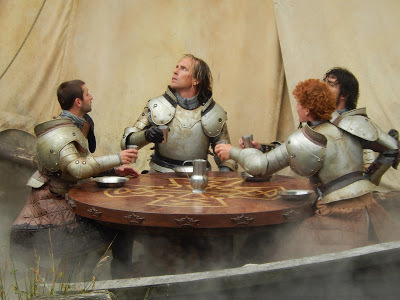
2016 was when I stopped dreaming about becoming an author and actually became one. It was an incredibly daunting experience — putting myself out there and choosing to go it alone. Was I mad? What was I thinking? I can remember the doubts that swirled around my mind. What if no one buys my book? What if it sucks? What if? What if? What if?
I am sure that sounds familiar to many authors and would-be authors out there. I was full of doubt, but I had to know… I had to know if I could do this. So I pressed that button on the 28th February 2016, and I became a published author. This had been my goal for so long and now I had done it. It was then that I abruptly came to the realisation that this wasn't the end of the journey — far from it — this was only the beginning.
 The Du Lac Chronicles ~ Amazon
The Du Lac Chronicles ~ AmazonI wrote The Du Lac Chronicles so that it would be read. This book wasn't going to go anywhere if I didn't promote it. I came into this knowing very little, and with a very small budget, but I realised if I didn't get smart about this then my book was going to sink and that would never do — I had spent too many years writing it. So I had to get savvy, but that is no easy thing. There were times when I felt like I was banging my head against the wall — why was nothing working? But then I would have a moment of insight and very briefly I would fly. And then it was back to the drawing board again. I still don’t have a magic formula, but I have now drawn up quite a list of things that don’t work in the confusing world of book promotion! I will get there in the end, I am very positive about that. I know it is a very steep hill to climb, I get that, but I hear that the view is worth it once you get to the top and I am determined to see it.
The one thing that has blown me away this year is how other authors want to help. They are happy to offer you advice and mentor you for free. I wasn't expecting that. For the most part, other author's don't look at you as the competition, it is more like a club — we are in this together — type of atmosphere — Let’s help each other as much as we can.
I now find myself surrounded by author friends from all over the world, who I would never have met if it weren't for me publishing my book. They say an author's world is a lonely one. Have I got news for you...!
So here I was, steering a bus that I sort of had control of and I came to the conclusion that publishing a book was all well and good, but I wanted to be a bestseller in my genre,
"Just like that…" as the late comedian Tommy Cooper used to say.
Tommy Cooper - Just Like That
Not quite how it works in the publishing industry, I'm afraid. But you know what, I did it. The Du Lac Chronicles made it to the #1 spot in the United Kingdom, America, Canada, Australia, Germany, The Netherlands, and Italy. I took a moment to reflect. But, being me, my eyes were drawn to the top #100 in the Kindle Store spot. It is a dream for most authors to get there, I mean come on, there are over 6 million Kindle books on Amazon, who wouldn’t want to be in the top #100? I needed to come up with a plan and it took a long time to work it out, and even then I wasn’t sure it was going to work. But you know what? The Du Lac Chronicles made it into the top #100 in the free Kindle Store in America, Canada and The Netherlands. Even now, writing that down, I find it hard to believe — I really did sell that many books. Not too bad an achievement for a girl who didn't know anything about Amazon or marketing a book a year ago and who doesn’t have a large budget to throw into advertising.
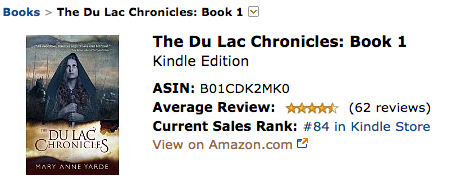
But then something else happened that I wasn't expecting. I had readers messaging me on Facebook and Twitter telling how much my books reminded them of Game of Thrones and then the comparison was bring made in reviews left on Amazon and Goodreads and I was like....okay! I am still lost for words when I read reviews like that, which may come as a surprise to some!
To cap it off, The Du Lac Chronicles has started to win awards.


While all this was going on, I released an interim-novella ~ The Pitchfork Rebellion and then on 6th December I released the second book in The Du Lac Chronicles series ~ The Du Lac Devil. The Du Lac Devil received a 5* review from Readers' Favorite.
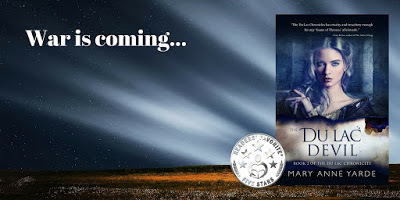
The Du Lac Devil ~ Amazon
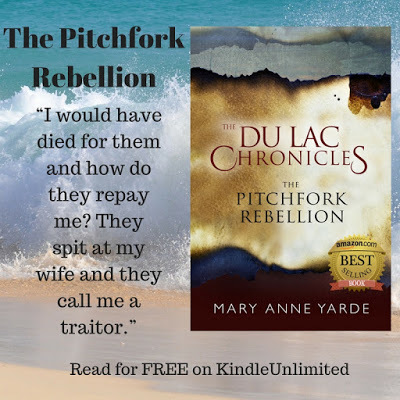
The Pitchfork Rebellion ~ Amazon
Likewise, this blog began to fly. When I wrote my first blog post back in 2015, I can remember thinking, what on earth am I going to write about? How am I going to come up with new posts ever week? 254 posts later, and 178,121 page views... I have discovered, to my delight, that I actually have an awful lot to say and I want to thank you for reading because a blog is only as good as its readers.
I have had some marvellous guests come onto this blog, and Wednesday's “Author's Inspiration” has been a huge hit. I don't know about you, but my reading list has gone through the roof because of it. There are so many great books out there — I want to read them all!!
So what next?
I am going to keep chasing that dream and learn everything I can about the publishing industry. I have started Book 3 in The Du Lac Chronicles. Yay! Unfortunately, one of my characters is giving me a little bit of a problem, it seems he wants in on the action, and I am having a tough time saying “No” to him. If you are a reader of my books, then I am sure you can guess who I am talking about! I really should stop fighting him for creative control. It is a losing battle — I know he will win in the end! But you see, if he muscles his way in, then that is okay. That is why I love being an Indie author — I have the freedom to write about what I want and say it the way I want to.
All that is left for me to say is a great big thank you to those who have supported me this past year by buying my books, and reading this blog. You are incredible. I really, really, appreciate it. I hope you have a peaceful New Year, and please don't forget to pop back in 2017 and say "Hello" every now and then. Just remember to bring that cup of coffee with you! Stay cool! xxx
Published on January 02, 2017 00:00
December 28, 2016
Author’s Inspirations ~ Larry Shackleford @larrydshack
It is with the greatest of pleasure that I welcome back Larry Shackleford onto the blog again! Larry is going to share with us his inspirations behind his latest book… The ReliquaryByLarry Shackleford
 The Reliquary is the sequel to The Keresa Headdress. The fast-paced crime fiction novel takes place in Salt Lake City, Utah. The unique cast of characters from the Keresa Headdress are back, along with new team members, to solve another extraordinary criminal investigation involving fossil theft and a psychotic killer. FBI Special Agent Karen Adams' career has flat lined since the exciting Keresa Headdress investigation, where she met Special Agent Marcus "Playboy" McCoy and her fiancé, archaeologist Derek Simms. Karen's supervisor, Roger Miller has since reassigned her to investigating mundane medical waste, fraud and abuse cases. Karen and Marcus are reunited as unlikely partners when a paleontology team goes missing in the remote Morrison Formation near Richfield, Utah.The missing persons case quickly escalates into a chilling nightmare that no-one could have expected. Karen and Marcus soon discover the murdered scientists along with missing Allosaurus fossils. The violent killer leaves few leads to pursue, and the team enlists Riley, a local polygamist and nudist, along with heavyset homicide detective, Colin Childs, to assist with the investigation. Marcus continues his “Playboy McCoy” antics until he meets Dr. Lisa Gruber, a paleontologist from the University of Utah who is unlike any woman he has ever met. Dealing with recent personal issues, Karen finds herself in another professional frustrating situation. Unfortunately, she must risk her own life as another case submerges her into the unimaginable underworld of antiquities theft and the criminally insane.Author’s Inspiration First of all, it is an honor and a privilege to be invited back to Mary Anne’s blog site! I have been a longtime fan of Mary Anne’s books; my friends and co-workers have all thoroughly enjoyed her Du LacChronicles series. The inspiration behind The Reliquary, the sequel to
The Keresa Headdress
(2015), was directly related to my interest in paleontology and the fascinating world of dinosaurs. During my law enforcement career, I had the opportunity to work on several investigations involving the theft of Allosaurusfossils on public land in the State of Utah. I even traveled to two different foreign countries to recover stolen fossils. Utah’s unique geology makes for world-class paleontology sites spanning millions of years of evolution. The Allosaurus was named the official Utah State fossil in 1988 because there are more Allosaurusfossils in Utah than anywhere else in the world.
The Reliquary is the sequel to The Keresa Headdress. The fast-paced crime fiction novel takes place in Salt Lake City, Utah. The unique cast of characters from the Keresa Headdress are back, along with new team members, to solve another extraordinary criminal investigation involving fossil theft and a psychotic killer. FBI Special Agent Karen Adams' career has flat lined since the exciting Keresa Headdress investigation, where she met Special Agent Marcus "Playboy" McCoy and her fiancé, archaeologist Derek Simms. Karen's supervisor, Roger Miller has since reassigned her to investigating mundane medical waste, fraud and abuse cases. Karen and Marcus are reunited as unlikely partners when a paleontology team goes missing in the remote Morrison Formation near Richfield, Utah.The missing persons case quickly escalates into a chilling nightmare that no-one could have expected. Karen and Marcus soon discover the murdered scientists along with missing Allosaurus fossils. The violent killer leaves few leads to pursue, and the team enlists Riley, a local polygamist and nudist, along with heavyset homicide detective, Colin Childs, to assist with the investigation. Marcus continues his “Playboy McCoy” antics until he meets Dr. Lisa Gruber, a paleontologist from the University of Utah who is unlike any woman he has ever met. Dealing with recent personal issues, Karen finds herself in another professional frustrating situation. Unfortunately, she must risk her own life as another case submerges her into the unimaginable underworld of antiquities theft and the criminally insane.Author’s Inspiration First of all, it is an honor and a privilege to be invited back to Mary Anne’s blog site! I have been a longtime fan of Mary Anne’s books; my friends and co-workers have all thoroughly enjoyed her Du LacChronicles series. The inspiration behind The Reliquary, the sequel to
The Keresa Headdress
(2015), was directly related to my interest in paleontology and the fascinating world of dinosaurs. During my law enforcement career, I had the opportunity to work on several investigations involving the theft of Allosaurusfossils on public land in the State of Utah. I even traveled to two different foreign countries to recover stolen fossils. Utah’s unique geology makes for world-class paleontology sites spanning millions of years of evolution. The Allosaurus was named the official Utah State fossil in 1988 because there are more Allosaurusfossils in Utah than anywhere else in the world.
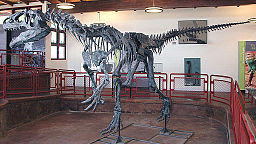
Allosaurus - Cleveland-Lloyd Dinosaur Quarry museum, Utah, USA
The Allosaurus was a late Jurassic-era bipedal top predator that lived approximately 145 to 150 million years ago in North and South America. It was smaller than its Late Cretaceous relative, the Tyrannosaurus Rex, weighing in at 1.5 – 2 tons as an adult, and measuring 30 – 40 feet long. Unfortunately, the irreplaceable fossil remains have also become a lucrative target for the black market. Similar to the illegal “pothunters” in archeological resource theft, the “rock hounds” of the paleo world have also capitalized on the theft of the rare and valuable resources. One femur bone from a well-known dinosaur can easily be sold on the black market for approximately $15,000 - $20,000 US dollars.
My goal with The Reliquary was to continue telling the story of Karen, Derek and Marcus, but this time I wanted to incorporate a plotline involving paleo theft. The challenge was not to simply make a sequel, but create a story that would stand alone without any previous knowledge of characters depicted in The Keresa Headdress. Also, I found that character development is very difficult when you are using characters from a previous story. I do not know if other authors will agree with this: writing fiction is truly rewarding in many ways, but there is also negative side to publishing your work. In a sense, you feel somewhat vulnerable and “exposed” wondering if readers will not only like your stories, but your characters as well. Right or wrong, it is interesting to witness other people discussing the characters that you have created. Positive and negative feedback from readers for an author is critical, but it is also interesting to see what individual readers glean from your stories. I would love to see Mary Anne create a small section on her blog that highlights comments authors have received from readers that have surprised them. For example, in one of my books, The Cherubim Rosewood (2015), the main character gives his long-time girlfriend his parents’ wedding rings shortly after completing a horrific journey through the Amazon jungle. In the book, he simply tells his girlfriend that he would like for her to keep the rings safe. I had a reader tell me that was one of the most unique, romantic ways she had ever read a wedding proposal. I thanked her for her kind comments, but when I wrote these words, the thought of a wedding proposal NEVER crossed my mind!Based on the feedback I had received from The Keresa Headdress, I was motivated to really develop the character Marcus McCoy in the story. So many readers absolutely loathed this character, so I strived to portray the human side of Marcus in the sequel, without condoning his unsavory shenanigans. I also wanted to introduce the historical side of fossils, their implications to modern times, and reveal the alarming rate in which fossils are used for illegal purposes. I also wanted to introduce a deeply troubled suspect. I will not go as far to say this story is based on a real experience or individual, but I will suggest that the best law enforcement stories are the ones that the general public will never hear about!
Links to PurchaseAmazon US
Amazon UK
About the author
 Larry was raised in southwest Missouri where he received his college degree, but he received his education after he graduated and began working in a maximum-security federal prison. After spending two years behind bars, he continued his law enforcement career as a criminal investigator, residing and working in eight states and two foreign countries. Larry retired from law enforcement after twenty-five years of service and resides in Salt Lake City with his wife and cat.
Larry was raised in southwest Missouri where he received his college degree, but he received his education after he graduated and began working in a maximum-security federal prison. After spending two years behind bars, he continued his law enforcement career as a criminal investigator, residing and working in eight states and two foreign countries. Larry retired from law enforcement after twenty-five years of service and resides in Salt Lake City with his wife and cat.
Published on December 28, 2016 00:00
December 24, 2016
Happy Christmas
Published on December 24, 2016 00:00
December 23, 2016
What did a War Time Christmas Look Like? #WW2 @Suzy_Henderson
A Wartime Christmas by Suzy Henderson
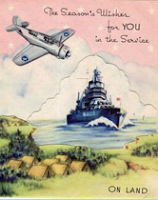 When I began writing The Beauty Shop, I decided that my male and female protagonist would meet at a New Year’s Eve dance held at an air base. The year was 1942, and it was the first Christmas the Americans would spend in England. While I’d read about service dances and budding romances, it seemed the war years were joyful and exciting, but I feel that was perhaps just a little light that shone through the ever-constant darkness. So, I went back in time, back to the 1940s, in search of a wartime Christmas.
When I began writing The Beauty Shop, I decided that my male and female protagonist would meet at a New Year’s Eve dance held at an air base. The year was 1942, and it was the first Christmas the Americans would spend in England. While I’d read about service dances and budding romances, it seemed the war years were joyful and exciting, but I feel that was perhaps just a little light that shone through the ever-constant darkness. So, I went back in time, back to the 1940s, in search of a wartime Christmas.December 1940 was a challenging month, and the first year the British people had to endure heavy bombings in some parts while preparing to celebrate Christmas. The Blitz had begun on September 7th, 1940, and by the end of the year, 24,000 people had been killed while hundreds of thousands became homeless. The Luftwaffe virtually destroyed the city centre of Coventry in November, while around 41,000 British Soldiers were captured on the continent. Many women now worked, children had been evacuated, and families split up. As many people mourned the loss of loved ones, many more feared for their fighting men, and for those displaced and homeless, Christmas must have seemed a very bleak prospect indeed.
Manchester suffered quite heavily between the 22 -24 December as the Luftwaffe launched bombing raids on industrial targets. One side of Manchester Piccadilly was virtually destroyed during the second night of attacks, with buildings set ablaze. Incendiary bombs caused hundreds of fires over two consecutive nights. Christmas and homes would have been destroyed for a number of people, along with the loss of lives. Fortunately, Britain and Germany made an unofficial agreement to refrain from any further bombing raids until the 27th December, an agreement that did not extend to ground or sea forces.
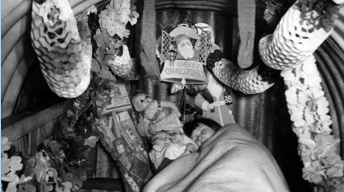 Small Christmas trees were in great demand as many families prepared to spend the day in their air raid shelters, in case the Luftwaffe should come again. Paper chains were made from scraps of paper, glued together and strung across rooms or shelters for decorations. The ration was beginning to bite, and many items including food and gifts were in short supply. The government discouraged the public from spending money on gifts and encouraged them to buy war bonds instead, to help the war effort. In doing so, they managed to raise around £10 million one week before Christmas.
Small Christmas trees were in great demand as many families prepared to spend the day in their air raid shelters, in case the Luftwaffe should come again. Paper chains were made from scraps of paper, glued together and strung across rooms or shelters for decorations. The ration was beginning to bite, and many items including food and gifts were in short supply. The government discouraged the public from spending money on gifts and encouraged them to buy war bonds instead, to help the war effort. In doing so, they managed to raise around £10 million one week before Christmas. 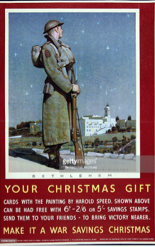
Image courtesy of Getty Images
“Make do and Mend” was the official slogan used prolifically throughout the war years. Everything that could be recycled was, including brown paper and string, which was so scarce and used over and over on parcels. Hand-made presents were the order of the day, including boats, trains and doll’s house furniture carved from wood while women made knitted items such as dolls, hats, and scarves from any spare wool they could find. Gifts were also generously donated by other countries and charities.
Christmas dinner was an ingenious affair. Turkey was simply unaffordable to the masses and many other cuts of meat, although cheaper, were still expensive. Many working class people turned to home-reared chickens and rabbits. The latter often became cherished family pets of children who would undoubtedly be upset to see them served up at Christmas. By now many people were growing their own vegetables and making chutney which would be a blessing for the dinner table at this time. Fruit was scarce, and there were very few imports, so Christmas cakes and puddings were made with substituted ingredients in place of dried fruit and marzipan as people became more resourceful in the kitchen.
While many people made the traditional visit to church that day, there was a distinct silence in the air as all bell ringing was banned, reserved only to signal the German invasion. The BBC broadcast a Christmas service from the ruins of Coventry Cathedral, and the Kings speech went ahead as usual via a radio broadcast. Most families would be sat huddled around the radio, listening intently at 3pm to King George VI as he addressed the nation. His speeches at this time throughout the war years became so popular with the people that they continue to this day. The entertainment of choice would be cards, singing songs, carols and listening to the radio.
On Sunday 29th December, the Luftwaffe returned with a vengeance, launching one of the heaviest raids of the Blitz so far, with fires that raged so ferociously it became known as the Second Great Fire of London. The city was burning, and one of the most powerful images of the entire war was taken that night of St Paul’s Cathedral; the dome of which rose untouched as flames danced all around. It was hailed as a miracle by the people, and St Pauls became a symbol of the will of the British, rising triumphant from the ashes. They would not be defeated, and they would not give in.
By December 1942, the Americans had joined the war, and the British people were asked to welcome a GI into their home at Christmas time. Many did, and forged friendships with those young men who were so far away from home. And of course, the GIs always took along their individual rations which were always gratefully received and helped deliver a little extra festive cheer.
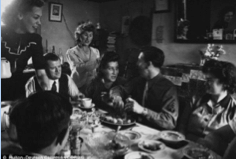
So, the British people demonstrated their indomitable spirits by smiling through the harshness and tragedy of war, determined that Hitler would not break them. They enjoyed the festivities as well as they could, making an effort for the sake of their children. They extended the hand of friendship to our American neighbours, ensuring that they too enjoyed this day in the company of others, with families to show them they were not alone. The true spirit of Christmas, generosity, compassion and friendship.
Today, we are far more fortunate, and I have no experience of the hardships the people faced back then, something I am most grateful for. Christmas is a time of peace, and of friendship, love, and extending hospitality to those less fortunate than ourselves. It is a time of giving, and we can all give so much to others, so much of ourselves, including our time – it’s not necessarily about buying presents. And remember, no one should be alone at this time unless they wish to be.
***
 Suzy Henderson was born in the North of England, but a career in healthcare would eventually take her to rural Somerset. Years later, she decided to embark upon a degree in English Literature with The Open University.
Suzy Henderson was born in the North of England, but a career in healthcare would eventually take her to rural Somerset. Years later, she decided to embark upon a degree in English Literature with The Open University. That was the beginning of a new life journey, rekindling her love of writing and passion for history. With an obsession for military and aviation history, she began to write. It was an old black and white photograph of her grandmother that caught Suzy’s imagination many years ago. Her grandmother died in 1980 as did her tales of war as she never spoke of those times. When she decided to research her grandmother’s war service in the WAAF, things spiralled from there. Stories came to light, little-known stories and tragedies and it is such discoveries that inform her writing.Having relocated to the wilds of North Cumbria, she has the Pennines in sight and finally feels at home. Suzy is a member of the Historical Novel Society and the Romantic Novelists Association. "The Beauty Shop" is her debut novel and is available here... AmazonUseful Linkshttp://www.suzyhendersonauthor.com/suzyhenderson.wordpress.comhttp://lowfellwritersplace.blogspot.co.uk/https://www.goodreads.com/author/show/15954239.Suzy_Hendersonhttps://www.facebook.com/SuzyHendersonAuthor/https://twitter.com/Suzy_Hendersonhttps://plus.google.com/u/0/109057622139171622985https://uk.linkedin.com/in/suzy-henderson-714a4353
Published on December 23, 2016 00:00
December 22, 2016
Christmas in Sherwood ~ #history #RobinHood #Sherwood @MichaelReuel
Christmas in SherwoodBy Michael Reuel

There’s a great deal of media debate flying around about how eventful 2016 has been, which for many is another way of saying how depressing it all is.
It started with David Bowie dying back in January and the arrows haven’t stopped flying ever since. Everyone’s favourite sheriff of Nottingham, Alan Rickman, was next, with Mohammad Ali, Prince, Gene Wilder, Leonard Cohen, Andrew Sachs, Kenny Baker, Victoria Wood, Terry Wogan and Zsa Zsa Gabor being just some of the names to follow who had earned remarkable public affection during their lifetime and let's not get started with the election results.
When faced with such a debacle, a look at history can often provide an ideal tonic for keeping our troubles in perspective. Indeed, even for those who insist there has been no silver lining to the events of 2016 and just want it out of the way, a look at other times can provide a compelling argument for shaking off the blues and getting in the Christmas spirit.
Because of my Robin Hood studies I confess to having spent much of the unhappy 2016 with my head stuck in fourteenth century England. My aim has been to recast Robin as the yeoman he always was before clumsy historians decided to give him noble blood and, in order to achieve this, I was required to find out as much as I could about a type of people that chroniclers too often overlook as important: the common folk.
Dredging up reliable information about a particular common person is an unenviable task – even if that person happened to become the most famed and celebrated hero of his day. Nevertheless, much can be said about the lives that these people lived; by tracing world events, the laws of the land and the behaviour of the ruling classes. Meaning that a sense of what they had to live through is not so obscure and only demands the use of our imagination.
OK so there is a blatantly obvious comparison to make here, in pointing out that medieval commoners had a tougher life than we face. They were a subservient and downtrodden people, likely to be poor and malnourished and with a low life expectancy.
They were different times. However, even with medieval expectations in mind, the fourteenth century can be described as tragic and hellish for what its people were destined to go through – and to an extent that vastly outweighs any of the bitterness we can possibly hold towards the days of 2016.
At first glance this appears strange in that, initially, the century appeared to be the dawn of a new era of optimism for the English nation in general. Edward III had kicked a usurper off the throne, before proceeding to turn around the nation’s military fortunes. By the time his reign was in full swing, the English people no longer needed to worry about invasions from the Scots and an inferior position to the French on the world stage had been completely overturned. They had perhaps England’s greatest achievements on the medieval battlefield to celebrate, at Crecy and Poitiers. Plus, they also had a king who embraced the cultural nourishment of his classes from top to bottom, staging courtly events, games and tournaments that gave the country a fresh and merry atmosphere it had not known. Though Victorian historians would later reject Edward III as a king to celebrate because of his excess and warmongering, there can be no doubt that his people loved him. They drew comparisons between his reign and King Arthur’s, at the same time as embracing a new national flag and patron saint whose colours he championed on the battlefield. Even the famous line... ‘The Pope may be French, but Jesus is English’ ...dates to this time.
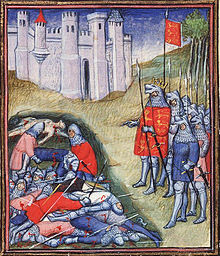 Edward III counting the dead on the battlefield of Crécy (Wikipedia)
Edward III counting the dead on the battlefield of Crécy (Wikipedia)So what went wrong? Well, the year that stuck in everyone’s craw back then was not one with 16 in it, but 48.
1348 was the year when all of that changed, because not only did loved and famous people die but pretty much half of Europe did too. The reason for this was the bubonic plague, which became known as The Black Death.
The disease wiped out whole communities, leaving the dead in so great a number that it became impossible to bury them. Being a great power did not save England from its misery and, even though the plague had left by 1350 (only to return in 1361), it appears to be the case that sickliness lingered on in the air and continued to take its toll regardless.
Edward III lost so many heirs to unnamed illnesses that only two of his 13 legitimate children were alive when he died in 1377. The country had also lost its favourite prince – Prince Edward; the hero of Poitiers who was known as ‘The Black Prince’ – so the succession had to go to his grandson, Richard II, who never came close to achieving similar popularity.
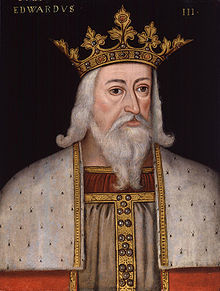 Edward III So it was that a vibrant kingdom then faced a desperate time in spite of its achievements… and yet even then the Christmas spirit was not allowed to diminish.
Edward III So it was that a vibrant kingdom then faced a desperate time in spite of its achievements… and yet even then the Christmas spirit was not allowed to diminish.Alan Rickman’s sheriff might have called off Christmas in Prince of Thieves, but Edward III did quite the opposite, embracing it with as much wealth and splendor as he was able. Even though he was himself mourning the death of two children, none of the events that had been organized to celebrate his victories were cancelled. Christmas saw an extravagant games event held at Otford, with another in Merton for Epiphany. Guests arrived dressed in elaborate costumes, including some who came as ‘wild men of the wood’, in what is likely a nod to the popularity of Robin and his Merry Men.
Robin Hood - Call Off Christmas Robin Hood Prince of Thieves ~ 1991
Though it is not possible to be exact with dates, the folklore suggests that Robin Hood died a decade or two before the Black Death arrived. But 1348 remains an important time for the Robin Hood stories, which were being told by the people who loved to hear them, as storytelling offered moral support and brought communities together through harsh times. It was this place in the people’s hearts that would eventually lead to the oral ballads being recorded on paper, so that we still have them today – even though historians largely choose to ignore the many revealing aspects of their content.
Unlike with a mighty king like Edward III, with a brave yeoman we only have the folklore to go on in order to know his story. And yet, this winter 2016 has presented us with a curious memento from his time and location, in the shape of a gold ring that has been found in Sherwood Forest.
Read the article here
A nice Christmas present for its finder (metal detector Mark Thompson, who looks to be around £70,000 better off for the happy coincidence), most media coverage has overlooked the possibility that this ring could indeed have belonged to one of the Merry Men.
Popular culture still directs people all the way back to King John’s time to find Robin Hood, but he was not there. His story began during the latter part of Edward II’s reign, but largely belongs at the start of Edward III’s. The ring has indeed been dated to the early thirteenth century and so it is entirely possible that a rich traveller had to reluctantly hand it over to a villainous but charming yeoman of the forest.
The ring is adorned with an image of the baby Jesus as well as one of the Virgin Mary whom, as the oral ballads consistently attest, was Robin Hood’s most venerated saint. He would certainly have appreciated the treasure and now the forest floor has given it up as a curiosity for us to wonder about.
It certainly wasn’t a Christmas present for Maid Marian though. That lass is pure fiction.
***
 Robin Hood Existed
Robin Hood ExistedFolklorist Michael Reuel delves into the legend of Robin Hood in order to assess how much we can learn by studying folklore, without applying the rigid terms of ‘historical’ proof. In the process he discovers that, although folklore does have obvious limitations in terms of what it can prove, the sheer amount of source material on Robin Hood is nevertheless sufficient enough to conclude that the famous outlaw and his Merry Men did in fact exist. Amazon
Published on December 22, 2016 02:23
December 21, 2016
Author’s Inspiration ~ Cynthia Ripley Miller #histfic @CRipleyMiller
It is with the greatest pleasure that I welcome historical fiction author, Cynthia Ripley Miller onto the blog to talk about her inspirations behind her latest book… On the Edge of Sunriseby Cynthia Ripley Miller
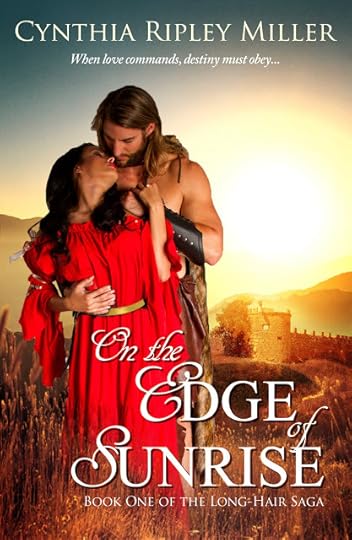
When love commands, destiny must obey. The year is AD 450. The Roman Empire wanes as the Medieval Age awakens. Attila the Hun and his horde conquer their way across Europe into Gaul. Caught between Rome’s tottering empire and Attila’s threat are the Frankish tribes and their ‘Long-Hair’ chiefs, northern pagans in a Roman Christian world, and a people history will call the Merovingians.
A young widow, Arria longs for a purpose and a challenge. She is as well versed in politics and diplomacy as any man … but with special skills of her own.
Emperor Valentinian, determined to gain allies to help stop the Huns, sends a remarkable envoy, a woman, to the Assembly of Warriors in Gaul. Arria will persuade the Franks to stand with Rome against Attila.
When barbarian raiders abduct Arria, the Frank blue-eyed warrior, Garic, rescues her. Alarmed by the instant and passionate attraction she feels, Arria is torn between duty and desire. Her arranged betrothal to the ambitious tribune, Drusus, her secret enlistment by Valentinian as a courier to Attila the Hun, and a mysterious riddle—threaten their love and propel them into adventure, intrigue, and Attila’s camp. Rebels in a falling empire, Arria and Garic must find the strength to defy tradition and possess the love prophesied as their destiny.
***Author’s InspirationAn avid reader of both fiction and history, I stumbled upon fifth century France and the world of the barbarian Franks, later called the Merovingians. I was immediately intrigued. My curiosity doubled when I discovered a different view of ancient Rome in this late antiquity period and its interaction with European barbarian tribes. The Roman Empire was on the brink of collapse and into this gap stepped the barbarians. Gregory of Tours, bishop, and sixth century historian, wrote in his work, The History of the Franks, of how the Franks rose from tribal chiefs and warriors to the acknowledged masters of Roman Gaul (France). Fascinated by this era of change and upheaval, I chose late ancient Rome and Gaul as the setting for my novel, On the Edge of Sunrise.
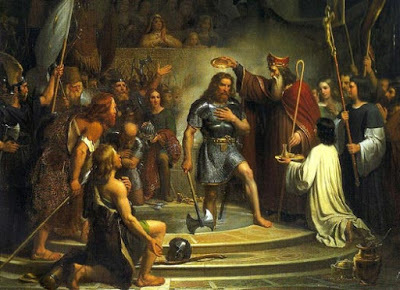 Clovis I ~ the first King of a united Frank
Clovis I ~ the first King of a united FrankHistory and PeopleBy the third century, the Germanic Franks were a federation formed of eleven tribal groups, which included the Salian Franks and the Chamavi. They occupied the territory on the east bank of the lower Rhine valley known as Gaul (modern Belgium and southern Netherlands) and in the later centuries as Francia/France.
Merovingian, the title given to the Franks, derives from Meroveus/Merovech one of the first kings of the Salian Franks. Around 450, he entered a power struggle with his older brother for the throne. Meroveus went to Rome to gain support from the Romans for succession as king against an elder brother who aligned with Attila the Hun for the same reason. Priscus, a Roman historian, wrote of Meroveus, “ … he was still very young and we all remarked his fair hair which fell upon his shoulders.” Frank nobles distinguished themselves from the commoner and other groups by wearing longer hair, despite the fashion, and were called ‘Long-hairs.’ The Salian Franks fought with Rome at the Battle of Catalaunum or Catalaunian Plains.
General Flavius Aetius, also referred to by some as the ‘last Roman’, served as the Master of the Soldiers from 429 to 454 and had a long career as a soldier and general. He won the Battle of Catalaunum against Attila the Hun in 451. After Attila’s death in 453, Emperor Valentinian III believed that Aetius conspired to put his own son, Gaudentius (betrothed to Valentinian’s daughter) on the throne. Valentinian felt threatened and stabbed Aetius to death as he read a financial account to him. With Aetius gone, the empire was vulnerable and left without a true defender. In 455, the Vandals sacked Rome.
Religion By the fifth century, most of the Roman Empire was Christianized, including many barbarian groups. However, reputable sources have recorded that the Germanic Franks were northern pagans in a Christian Roman Empire. Little evidence exists regarding their precise spiritual beliefs, especially in the fifth century. Yet they were a Germanic tribe.
The references to Germanic pagan deities that we have today illustrate some parallels to the Norse pantheon of Gods of Viking Scandinavia, and whose Scandinavian sources were recorded 500 to700 years after some of the earliest Continental Germanic sources. Gods such as Wodan (Norse-Odin), Thunar/Donar (Norse-Thor), and Tiwaz/Ziu (Norse-Tyr) are thought to be Continental Germanic and Norse counterparts.
One example in particular is the South German Nordendorf Fibula (6th century AD). It has a runic inscription that mentions the deities Wodan, Donar and Logathore recognizable equivalents to the Norse gods, Odin, Thor and possibly, Loki. In my novel, I took some liberty by using both the Continental Germanic and Norse equivalents. For example, Thor is better known than Donar, but Wodan offered a stronger Germanic tone; Tiwaz as a name predates Ziu. Gregory of Tours wrote from his Gallo-Roman perspective: “… They [Franks] did not recognize the true God. They fashioned idols for themselves out of the creatures of the woodlands and the waters, out of birds and beasts: these they worshipped in the place of God, and to these they made their sacrifices.”
The Franks remained pagan until Clovis. He united all the Frank tribes under one ruler to become their first official king and converted to Christianity in 496.
5th Century Products and Domestic LifeThe most important role for a Roman woman was as a wife and mother. Mothers passed on their domestic skills to their daughters, but historians write that girls and boys attended primary school. Girls from elite families learned Latin and Greek. Girls and boys sang in choirs and attended social events. Women from the upper classes appear ‘well-educated, some highly so, and at times praised by historians for their learning and cultivation.’ Freeborn women were citizens but could not vote or hold office; however, women played an active role in trying to persuade the government to adopt certain policies. Although Roman women held no direct political power, those from wealthy or powerful families could and did influence through private negotiations.
The currency at the time was the Denarius and Solidus. Braziers (a portable heater) were stoked by wood, charcoal and coke; oil lamps for light and heat. Rural farms used center room fire pits.
Barbarian men wore tunics with leggings and the women tunic style dresses. Brooches were used to secure capes and robes together. Roman men wore uniforms if in the military and on duty, otherwise tunics without leggings. Togas were more for dress or ceremony. Roman women wore the stola, a draped, belted dress. Barbarians liked mead. Romans liked watered down or sweetened wine. However, they would not pass up what was available to them!
The fifth century is an era rich in drama and ripe for storytelling. I sought to bring my heroes, Arria and Garic, to life in an age not only changing in cultural perspectives, but also, one struggling to be born.
Quoted Sources: Gregory of Tours, The History of the Franks; Beryl Rawson, The Family in Ancient Rome: New Perspectives; Bertrand Lançon: Rome in Late Antiquity
Links To PurchaseAmazon USAmazon UKB&N
About the author
 Cynthia Ripley Miller is the author of On the Edge of Sunrise, the first novel in the Long-Hair Saga, a series set in late ancient Rome and France and a Chanticleer International Chatelaine Award finalist. She has lived and travelled in Europe, Africa, North America and the Caribbean, taught history and currently teaches English.
Cynthia Ripley Miller is the author of On the Edge of Sunrise, the first novel in the Long-Hair Saga, a series set in late ancient Rome and France and a Chanticleer International Chatelaine Award finalist. She has lived and travelled in Europe, Africa, North America and the Caribbean, taught history and currently teaches English. Her short stories have appeared in the anthology Summer Tapestry, The Scriptor, and at Orchard Press Mysteries.com. Cynthia blogs on her website, http://www.cynthiaripleymiller.com and at Historical Happenings and Oddities: A Distant Focus.
She lives with her husband and their cat, Romulus, and German Shepherd, Jessie, in a suburb of Chicago. Book Two: The Quest for the Crown of Thorns will be published in October of 2016.
Useful Links Website: http://cynthiaripleymiller.comFacebook:https://www.facebook.com/cynthiaripleymiller/Blog: http://cynthiaripleymiller.wordpress.com/Twitter: @CRipleyMiller
Published on December 21, 2016 00:00
December 20, 2016
How the Romans celebrated Christmas #history @Oldbrookender
How the Romans celebrated Christmas
 Verulamium Walls
Verulamium WallsWhen I first decided to write ‘Divided Empire’, I had to wanted the book to commence in what is now the month of December 390 AD and have Flavius and Siward rescuing Corellia, whilst she was on her way to celebrate the Christ Mass at Gesoriacum. I then began to wonder whether Christmas, or Christ Mass, would have been celebrated in the late fourth century Western Roman Empire. I decided that I wasn’t sure about this and so decided to move the events of the book, on to the summer of the following year. I like to research the events in my books as accurately as possible and realised that Christmas in Roman times was an area that I knew little about and so decided to find out more.
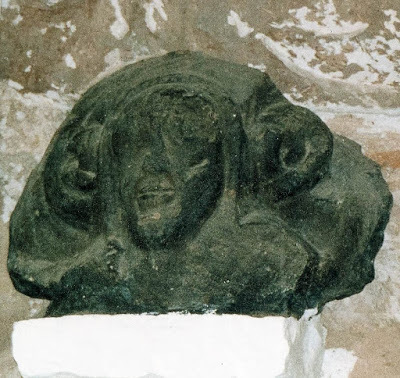 CernunnosI was aware that the Romans celebrated a festival called Saturnalia and knew that it took place towards the end of the year, but my knowledge was sketchy. Researching Saturnalia, I found out that it was originally dedicated to the god Saturn and was celebrated in December. Winter festivals have always been popular amongst different societies. Macrobius, a Roman who lived during the early 5th Century AD had written about the origins of Saturnalia and in one of the interpretations of his work Saturnalia is described as a festival of light leading up to the winter solstice which occurs on the 21st or 22nd of December. The timing of Saturnalia made sense to me, it is after all the time of the shortest and quite often the darkest days and it is human nature to want to have something to look forward to.
CernunnosI was aware that the Romans celebrated a festival called Saturnalia and knew that it took place towards the end of the year, but my knowledge was sketchy. Researching Saturnalia, I found out that it was originally dedicated to the god Saturn and was celebrated in December. Winter festivals have always been popular amongst different societies. Macrobius, a Roman who lived during the early 5th Century AD had written about the origins of Saturnalia and in one of the interpretations of his work Saturnalia is described as a festival of light leading up to the winter solstice which occurs on the 21st or 22nd of December. The timing of Saturnalia made sense to me, it is after all the time of the shortest and quite often the darkest days and it is human nature to want to have something to look forward to.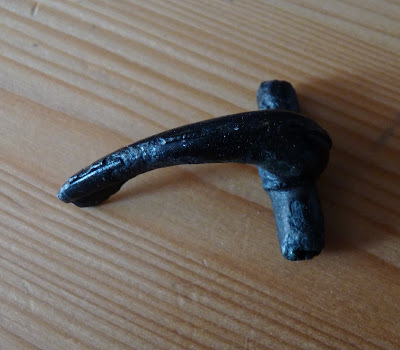 Roman Dolphin Brooch As I delved into the history of Saturnalia I found that other writers
Roman Dolphin Brooch As I delved into the history of Saturnalia I found that other writershad written that Saturnalia had been the merging of three winter festivals. In the later Roman Empire “the Birthday of the Unconquerable Sun” was celebrated and a calendar dated to AD 354 gives the date of the celebration to the 25th of December. The length of the Saturnalia celebrations also varied in accounts from two to seven days, but all the commentators on the vent seemed to agree that it took place during the period of 17th to 25thDecember.
 Multangular TowerSo, what form did the Saturnalia celebrations take? There were various accounts of the celebrations from several commentator’s, the consensus being that it was a time of feasting, drinking, singing (naked in the streets according to one account), dancing, gambling, gift-giving and general revelry. The normal social norms were relaxed and for the duration of Saturnalia masters and slaves became equals. So, one would expect it to have been a popular festival, but apparently, it wasn’t for everyone. Seneca is said to have complained that the mob went out of control “in pleasantries”, whilst Pliny the Younger retired to his garden summer house so that the noise of his servant’s merry making wouldn’t interrupt his studies. Still some enjoyed it and even the Roman Emperors joined in by giving gifts at Saturnalia.So, what happened when the Emperor Constantine 1 (known as Constantine the Great) converted to Christianity, did Saturnalia become Christmas? Well at first there were not a great many changes. The Edict of Milan extended toleration to Christians and ended their persecution, but the Christian Church was at this time however a divided one, due to the schisms within it and pagan worship continued. It should also be realised that for the early Christians, the actual date of Jesus’ birth hadn’t been decided upon and variations were March 28th, September 11thand November 18th. For the early Christians Easter was a more important date as a holy day.By the 4thcentury however Christianity was becoming the more dominant religion in the Roman Empire. The Emperor Theodosius’ edict in 384AD made public sacrifices and pagan religious ceremonials capital offences and by 392AD all pagan worship was prohibited. The early Christian leaders knew however that banning a popular festival such as Saturnalia would cause unrest and so in the 4th century they adopted it and turned it into a Christian one. It is said that large numbers of pagans were converted to Christianity on the understanding that they could continue to celebrate Saturnalia as Christians. Eventually in the late 4th century the 25th December, the last day of Saturnalia was settled upon as the date for Jesus’ birthday (although later the Orthodox Church in the Byzantine Empire fixed the date of Christmas as the 6thJanuary). Hopes that the Christian’s leaders may have had that some of the excesses of Saturnalia would be curbed when it became a Christian festival, didn’t always materialise. There are accounts that the earliest Christmas holidays were still celebrated by drinking to excess, sexual indulgence and singing naked in the streets. So, it seems that the Christmas we celebrate today had its roots firmly in the pagan festival of Saturnalia. Even the tradition of party hats appears to have come from the Saturnalia celebrations, where it was traditional for all men, regardless of status, to wear a pileus, a pointed felt hat. So why not this Christmas, instead of, or as well as saying Merry Christmas, don’t we all say “io Saturnalia” and recognise where the Christmas celebrations originated.
Multangular TowerSo, what form did the Saturnalia celebrations take? There were various accounts of the celebrations from several commentator’s, the consensus being that it was a time of feasting, drinking, singing (naked in the streets according to one account), dancing, gambling, gift-giving and general revelry. The normal social norms were relaxed and for the duration of Saturnalia masters and slaves became equals. So, one would expect it to have been a popular festival, but apparently, it wasn’t for everyone. Seneca is said to have complained that the mob went out of control “in pleasantries”, whilst Pliny the Younger retired to his garden summer house so that the noise of his servant’s merry making wouldn’t interrupt his studies. Still some enjoyed it and even the Roman Emperors joined in by giving gifts at Saturnalia.So, what happened when the Emperor Constantine 1 (known as Constantine the Great) converted to Christianity, did Saturnalia become Christmas? Well at first there were not a great many changes. The Edict of Milan extended toleration to Christians and ended their persecution, but the Christian Church was at this time however a divided one, due to the schisms within it and pagan worship continued. It should also be realised that for the early Christians, the actual date of Jesus’ birth hadn’t been decided upon and variations were March 28th, September 11thand November 18th. For the early Christians Easter was a more important date as a holy day.By the 4thcentury however Christianity was becoming the more dominant religion in the Roman Empire. The Emperor Theodosius’ edict in 384AD made public sacrifices and pagan religious ceremonials capital offences and by 392AD all pagan worship was prohibited. The early Christian leaders knew however that banning a popular festival such as Saturnalia would cause unrest and so in the 4th century they adopted it and turned it into a Christian one. It is said that large numbers of pagans were converted to Christianity on the understanding that they could continue to celebrate Saturnalia as Christians. Eventually in the late 4th century the 25th December, the last day of Saturnalia was settled upon as the date for Jesus’ birthday (although later the Orthodox Church in the Byzantine Empire fixed the date of Christmas as the 6thJanuary). Hopes that the Christian’s leaders may have had that some of the excesses of Saturnalia would be curbed when it became a Christian festival, didn’t always materialise. There are accounts that the earliest Christmas holidays were still celebrated by drinking to excess, sexual indulgence and singing naked in the streets. So, it seems that the Christmas we celebrate today had its roots firmly in the pagan festival of Saturnalia. Even the tradition of party hats appears to have come from the Saturnalia celebrations, where it was traditional for all men, regardless of status, to wear a pileus, a pointed felt hat. So why not this Christmas, instead of, or as well as saying Merry Christmas, don’t we all say “io Saturnalia” and recognise where the Christmas celebrations originated. Historical Fiction author, Brian Kitchen, lives in Burton upon Trent, England and enjoys walking in the countryside, photography, reading, writing, visiting museums and historic sites & buildings and supporting Burton Albion. He first became interested in the history of Roman Britain as a child and loved the Eagle of the Ninthtrilogy of novels by Rosemary Sutcliff. The Flavius Vitulasius series by Brian Kitchen:Divided Empire ~ Amazon Dark Betrayal ~ AmazonShould you wish to know more about Flavius & his friends, please visit his website & Facebook page:
Historical Fiction author, Brian Kitchen, lives in Burton upon Trent, England and enjoys walking in the countryside, photography, reading, writing, visiting museums and historic sites & buildings and supporting Burton Albion. He first became interested in the history of Roman Britain as a child and loved the Eagle of the Ninthtrilogy of novels by Rosemary Sutcliff. The Flavius Vitulasius series by Brian Kitchen:Divided Empire ~ Amazon Dark Betrayal ~ AmazonShould you wish to know more about Flavius & his friends, please visit his website & Facebook page:facebook.com/FlaviusVitulasius
www.briankitchen.me.uk
Published on December 20, 2016 00:00
The Coffee Pot Book Club
The Coffee Pot Book Club (formally Myths, Legends, Books, and Coffee Pots) was founded in 2015. Our goal was to create a platform that would help Historical Fiction, Historical Romance and Historical
The Coffee Pot Book Club (formally Myths, Legends, Books, and Coffee Pots) was founded in 2015. Our goal was to create a platform that would help Historical Fiction, Historical Romance and Historical Fantasy authors promote their books and find that sometimes elusive audience. The Coffee Pot Book Club soon became the place for readers to meet new authors (both traditionally published and independently) and discover their fabulous books.
...more
...more
- Mary Anne Yarde's profile
- 159 followers




